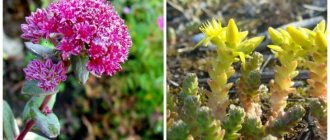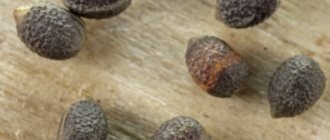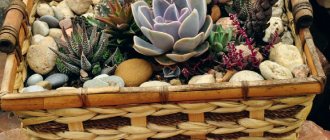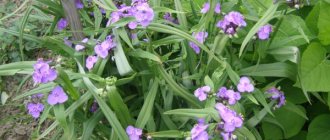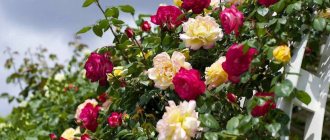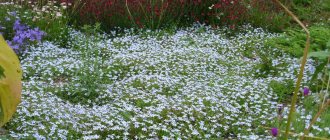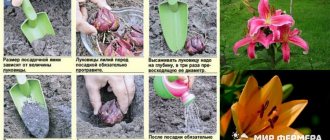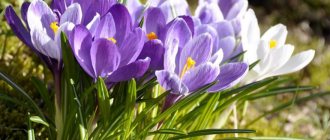The genus of semi-shrub succulents - Delosperma - is represented by a wide variety of shapes and colors. Colorful borders, flower beds, and alpine slides are created with the help of these amazing cover plants.
For long-term and successful cultivation at home and in the garden, you need to know all the intricacies of care. But first you need to choose the right variety, depending on where the plant “pet” will live. Frost-resistant specimens are selected for open ground; heat-loving specimens are suitable for indoor keeping. Proper watering, light, soil and many other subtleties will help you admire the multi-colored plant “mat” throughout the spring-summer flowering season.
Popular types
Species diversity amounts to hundreds of representatives. These are mostly indoor plants. But there are also cold-resistant specimens. They can be found in street flower beds. It’s worth getting to know both of them:
Delosperma floribundum
Lush flowering from many inflorescences occurs in the summer. The flowers barely reach three centimeters in diameter. The color is interesting: pink or purple oblong petals frame a white core. This species blooms in the same year that it was planted. This allows you to grow the succulent as an annual.
profusely blooming
Delosperma "Stardust" (D. Stardust)
A variety for long-term outdoor cultivation. Overwinters covered. Tolerates frosts below -20°. Flowers with white centers and pink endings on long petals. There is also a purple color with a lilac tint.
star dust
Delosperma Cooper (D. Cooperi)
Well branched plant, no higher than 15 centimeters. The shoots extend to almost half a meter in width. It withstands low temperatures well (down to minus seventeen degrees). Glossy and silky flower petals surround a creamy yellow center. The diameter of the flowers is larger than the previous type, up to five centimeters.
Cooper
Delosperma Twisted (D. Сongestum)
Frost resistance allows you to tolerate twenty-degree negative temperatures. The stems and castings create a dense green cover. In turn, bright yellow flowers cover the entire surface of the plant. Flowering begins in May. In the fall season, the greens give way to burgundy.
Twisted
Delosperma Tradiscantoides (D. Tradescantioides)
Long shoots “crawl” along the ground. When landing on a hill, they hang down. In appearance it resembles Tradescantia itself. The leaves are light and green. The flowers are small, snow-white.
Tradiscanceid
Dyer's Delosperma (D. Dyeri)
Hybrid with flowers in peach tones. Popular as an indoor specimen. Winters well. Tolerates frosts of minus 29 degrees. Varietal variations differ in color palette.
Dyer
Delosperma Pearl (D. Jewel) includes several varieties:
- Jewel Of Desert Opal – purple;
- Desert Pearl Garnet (Jewel of D. Garnet) – pomegranate petals, white-pink core;
- Desert Pearl Ruby (Jewel of D. Ruby) - flowers are red and purple.
Also read: Aloe agave - medicinal properties and contraindications. Healthy recipes
Pearl
Delosperma Cloudy (D. Nubigenum)
Literally creeping “green stuff”. Height up to ten centimeters. Evergreen species. Survives at 23 degrees below zero. Flowering is represented by small, juicy shades of orange and yellow.
Cloud
Delosperma Sutherlandii (D. Sutherlandii)
The leaves and trunks have soft pubescence. Large flowers of rich lilac tone. The core is light yellow. Good cold resistance (-23°). It is a low-growing species.
Sutherland
Delosperma Lehmannii (D. Lehmannii)
Representative of indoor varieties. Decorative leaf formations. The leaf shape is triangular pyramid. Associated with a children's puzzle. Light yellow flowers.
Leman
General description of the plant
The flower took its unusual name by combining two Greek words: visible “delos” and seed “sperm”, since the seeds of this plant completely lack a membrane covering.
The plants in the flowerbed reach a height of 10−30 cm. The stems are branched and creep. The leaves are elongated, lanceolate, fleshy, green or green-gray in color, the surface is smooth or covered with bristles; there are varieties with pointed papillae. A distinctive feature is that iridescent calcium crystals stand out on the surface, which look like ice.
The rhizomes are fleshy, thickened or with tubers, which serve to preserve moisture reserves.
Delosperma flowers are star-shaped in white, yellow, pink or purple, sometimes the petals are shiny. The diameter of the flower is no more than 7 cm. In bad weather conditions or at night, they close to protect the precious pollen. Flowering is abundant and long-lasting, in some species it begins in spring and lasts until autumn.
There are fruit boxes with a large number of nests. Such boxes open when water gets on them. The seeds are very small and scattered over a distance of no more than 150 cm. This explains the narrow distribution of delosperma in the wild.
Care
It is necessary to place Delosperma in the place most warmed by the rays of the sun. Neither heat nor drought can harm it. Dense, fleshy leaves store enough moisture to overcome dry periods. It is common for a plant to get sick and die from excess water (flooding, dampness).
Watering
- Watering activities are carried out strictly in the morning;
- The regime is observed relative to the seasons;
- During the period of intensive growth and flowering, the soil is allowed to dry out slightly between moistenings.
When “walking,” household residents will need to be protected from rainfall in order to prevent excessive soil moisture. During the rest period, the indoor inhabitants are allowed to dry out the earthen clod halfway.
Lighting
A lover of light requires open sunny corners. For home use, south-west, south-east or south windows with sufficient direct rays are suitable. Those growing in a flower garden need sun throughout the day. Growing in the southern regions requires light shading in the afternoon. Individuals planted in constant shade will stretch out and refuse to bloom.
Temperature
- In summer, it can quite easily withstand heat of +40 degrees for some time. The optimal temperature is about +27 degrees;
- The winter period is characterized by a decrease in thermal comfort to +7 – 10 degrees. Small fluctuations are acceptable in both directions for a fairly short time interval.
Humidity
There are no special requirements. In extreme summer heat, it is recommended to spray the area around the green carpet.
The soil
Must be:
- Light loose consistency. Promotes free growth of the root system;
- With good drainage qualities (water does not stagnate, protecting the flower from various types of rot);
- Poorly saturated with nutrients;
- Low acidity. The permissible upper limit is 6.5 pH.
Homemade soil is mixed from the following components:
- The land is turf;
- Leaf humus;
- Perlite one part;
- Brick crumbs, ten percent is added to the entire mass;
- Charcoal in the same ratio as brick;
- The surface is covered with moss or stones to reduce evaporation and maintain soil moisture for a longer time.
Transfer
Houseplants should be replanted only as needed. The reason for this may be a cramped pot, diseases and pests, rotting of the root system. It is recommended to transplant in the spring, before the growth stage begins.
Also read: Ceropegia - a climbing frame plant
Fertilizer
Additional fertilizing should be applied if you have not transplanted the plant into new soil for more than two years. A complex mineral fertilizer is used, diluted in water, in half the dosage specified in the instructions. Oversaturation has a bad effect on growth and flowering. The shoots become very elongated and fewer flowers are produced. The optimal application regime is from mid-spring to mid-summer, with an interval of three weeks.
Growing
Many varieties of delosperma do not survive winters of temperate climates, so the issue of its propagation remains relevant. The most convenient way is to plant seeds. In order for the plant to have time to grow stronger and bloom, seedlings are first grown.
To ensure natural stratification for the seeds and speed up the emergence of seedlings, lumps of snow are lined in an even layer in a container with light peat soil, and the seeds are poured onto them. Melted snow moistens the soil and draws seeds inside. After the snow melts, the container is placed in a bag or covered with film and placed in the refrigerator for 2 weeks. Then the box is placed on the windowsill and the first shoots are expected within 10-12 days. After the sprouts appear, the shelter is removed and the soil is carefully moistened. With the appearance of 4-6 true leaves, they are picked into separate pots and a week later they are planted in open ground.
All year round when grown indoors (or in the summer when grown outdoors), cuttings can be separated from an adult plant. They are immediately placed in the soil, carefully watered and wait for rooting.
Reproduction (planting)
You can obtain fresh specimens for garden and home maintenance by sowing seeds on seedlings and cuttings. Each method is good in its own way:
Seeds
In indoor conditions, you can start obtaining spring planting material for flower beds a little after the middle of winter. The seedlings have time to grow stronger and produce early flowering.
- Natural stratification of seeds is achieved by using peat soil with snow. To do this, you need to place the prepared soil in a container, scatter the seeds on top and cover them with a small layer of snow. Having melted, the snow moistens the soil, slightly settling the seeds;
- The container is covered with film and placed in a cool place for half a month;
- The next step is adding lighting;
- The sprouts that appear must be opened. The soil should be moistened little by little, depending on how dry it is;
- At the stage of four or six grown leaves, picking is done into individual vessels;
- After preliminary hardening, the seedlings can be placed in the flower garden, provided there are no night frosts.
Cuttings
- At any point where the plant touches the ground, young roots are formed. By carefully lifting the stem, you can see areas with root shoots. Cuttings can be separated from adult specimens throughout the entire vegetative growth. When kept indoors, this process is year-round;
- A section with roots is separated from the stem and placed in a separate container or in a flower bed. A cutting with roots and young leaves is able to grow independently. If no roots have formed, the shoot is cut into pieces, no more than 7 and a half centimeters. Dry for two hours (until a protective film appears on the cuts);
- Cuttings are planted one by one in a plastic container filled with sand or a ready-made mixture for cacti. The pots are placed in a well-lit place. Watering is carried out carefully, without overwatering the soil or getting on the seedling. After a few days, the young plant took root;
- You can grow roots by placing the cutting in a jar of water. When it appears, place the new individual in a vessel with earth. After two months, the plant is ready to be planted in the garden. The soil on the planting site should be nutritious, soft, and not retain water.
To achieve looseness and good drainage, peat or sand component is added. The planting scheme provides for a distance of about half a meter between the Turks under the sprouts. The reason for this is the rapid growth of the surface of the ground part and the rhizomes underneath it.
How to care for delosperma
Where to plant
Delosperma is planted in the warmest and most illuminated areas. She is not afraid of drought and heat. Its dense leaves retain a lot of moisture, with the help of which delosperma survives periods of drought. Excessive dampness or flooding has a negative effect on plants.
Suitable soil
For planting, choose loose, nutritious soil without stagnant water. It is recommended to first add peat or sand to the soil to dry and loosen the soil. Ready seedlings are transplanted to the opening of the site as early as possible. The ground part and rhizome quickly grow in width, so they need a lot of free space. Plantings are placed in holes at a distance of 40-50 cm from each other.
Feeding
For rapid rooting and active flowering of delosperma, it is recommended to feed it. It is best to use mineral fertilizers. They are bred in water and the areas with delosperm are gradually watered. It is necessary to water the plants very carefully, because drops of water can accumulate in the axils of the leaves. This often leads to the formation of puddles in the ground under the plants. The thickets of delosperma are very dense, the sun and wind do not sufficiently warm and dry the ground. Due to dampness, the rhizome can rot and the plant will disappear.
Preparing for winter
In late autumn, it is recommended to dig up annual varieties and clear the area of dead rhizomes. Winter-hardy varieties need to build a shelter, as they suffer greatly from excess moisture during the thaw period. To do this, a frame is built and the plants are covered with film. In severe frosts, artificial insulation is used to additionally retain heat.
In winter, it is recommended to move plants grown indoors to a cool, well-lit place. They require rest and reduced watering. They will grow actively from next spring.
Delosperma in landscape design and facade decoration
Delosperma plants are short growing. They can completely cover the entire surface with their greenery and flowers. This property leads to the fact that plants are often planted in rock gardens, rock gardens and arboretums.
Delosperma decorates balconies and verandas very beautifully. Flowerpots with these flowers can be seen near cafes, restaurants or in parks. To create decorative compositions, it is planted together with other plants and flowers. The most suitable for this are petunia, chistema, sedum, and lyubelia. Delosperma looks impressive next to small coniferous plants and juniper bushes.
Trimming
Pinching or trimming is carried out as necessary. Serves as a stimulating effect:
- For growth. Tall stems are subjected to the process. The very top is removed;
- For flowering. The occupied flowers are removed;
- Increased decorativeness. Cleaning of sluggish, dead and diseased leaves and shoots;
- Relief of stressful conditions during transplantation. Several leaves are cut off at the bottom using cuttings or seedlings.
Also read: Cotyledon - introduction to the types and care of the plant
Species widely used in floriculture
According to the latest data from the international register, the genus includes 175 species. The use of delosperma in culture began in the second half of the 18th century. About 15 species have become widespread as plants for gardens, flower beds and rockeries. The Czech florist studied the properties of many species, among which he identified the most decorative and cold-resistant:
D. cloudy (lat. D. nubigenum) is one of the most frost-resistant representatives of the genus. The height of the subshrub reaches 10 cm, the leaves are small oval. At low temperatures, the green color changes to bronze. Very expressive star flowers from amber to fiery orange.
D. Cooper (lat. D. cooperi) is a low shrub, occupying an area of about 1 sq.m. with fleshy succulent foliage. Many bright magenta-lilac flowers, 5 cm in diameter, are similar in appearance to the inflorescence of the basket. They are located on low shoots.
Delosperma in an unusual flower garden
D. twisted (lat. D. congestum) is a very hardy species. The height does not exceed 10 cm, so during the flowering period the foliage is practically invisible. A continuous floral carpet is formed. The flowers are very similar in appearance to daisies, usually bright golden in color. When they fade, the plant does not lose its attractiveness. The beautiful succulent foliage is also very decorative.
D. Sutherlandii (lat. D. sutherlandii) is distinguished by very delicate fluffy flowers with a light halo inside and a yellow center. The foliage is shiny and dark green in color.
D. dyeri (lat. D. dyeri) is one of the most luxuriously flowering species. The flowers are very large, rich carmine color. And the smooth shiny surface of the petals only emphasizes its beauty.
D. profusely flowering (lat. D. floribundum) blooms in the first year of sowing. Its whitish-green foliage combined with numerous light lilac flowers will create a lovely blooming picture in any flower bed. The plant is quite winter-hardy.
Various varieties obtained by hybridization of the above species are also popular. For example, it was possible to obtain varieties with white ('White Nugget') and two-color flowers ('Fire Spinner').
Bloom
The flowering period of delosperma is very long. The first “swallows” open at the end of May. You can admire the bright colors of flowers until late autumn. Single flowers in large numbers create colorful blankets of various sizes (depending on the area occupied by vegetation). The appearance of an individual flower is voluminous, due to the middle spherical filling of small petals.
The frame is formed by long oblong petals, arranged in one dense row or in several layers. The color range is rich in palette. From snow-white to deep purple shades. There are varieties that differ in the transitions from one color to another within each blossoming bud.
One important feature of this succulent should be taken into account - it blooms only in sunny weather. The predominance of cloudy days can deprive you of the opportunity to see a colorful meadow for the entire season.
Delosperma in landscape design and facade decoration
Most often, delosperma is used as a ground cover crop, because it completely covers the surface of the earth with its thick greenery and numerous flowers. This plant can be used in carpet plantings as an alternative to lawn grass. Multi-colored flowering bushes look great in rock gardens, rockeries and various rocky gardens.
Delosperma is well suited for decorating building facades; it decorates the outer sides of window openings, balconies and verandas. Bushes planted in pots and vases are used to create different ampelous compositions. Interesting combinations of this succulent with other flowers and plants (sedum, petunia, lobelia, cinneraria, etc.). Compact, beautifully flowering bushes look harmonious against the background of low conifers.
Diseases and pests
Delosperma is rarely susceptible to diseases and attacks by harmful insects. With proper care, you can avoid the appearance of various rots that can arise as a result of abundant and frequent watering, poor drainage function of the soil (stagnation of water).
Frequently observed pests include:
- Mealybugs. To treat plants, an insecticidal preparation with the active ingredient cypermethrin is used;
- Aphid. For mild lesions, a solution based on laundry soap has proven itself to be effective. Diluted in hot water at the rate of 15-17 grams per liter (a piece of soap per ten liters of water). When cooled, it is used to spray the shoots;
- Spider mite. It is necessary to collect as much as possible the representatives and their metabolic products with a soaked cotton swab from all accessible parts of the plant. The next step is to treat the entire flower with an acaricidal biological or chemical agent.
2.Delosperma - planting and care
2.1.Growing at home
In summer, the plant will feel great in the fresh air, protected from wind and rain. Remove fading flowers to prolong the flowering period.
It blooms from early spring until the first severe frost; the flowering period is very long.
2.3.Containment temperature
In spring, summer and autumn, delosperma is kept at normal room temperature. In winter, it is necessary to give the plant a rest period for more abundant flowering and place it in a cool room with a temperature of about 12 ° C.
Some types of delosperma can withstand frosts down to -17° C.
2.4.Lighting
They prefer a brightly lit place, but when exposed to direct sunlight during the day, delosperma leaves may acquire a red tint.
2.5.Soil for growing in a pot
The main requirement of delosperma is excellent drainage. For the rest, nutritious loose soil with a fairly high organic content is suitable.
During the growing season, delosperm is fed 2 times a month with liquid fertilizers.
2.7.Spraying
Spray periodically during the warm season. Keep dry in winter. Imagine a place where the delosperma will receive sufficient air movement without cold drafts.
Water sparingly during the growing season. Plants tolerate heat and drought well. In winter, reduce watering even more.
In spring, before flowering.
Seeds and stem cuttings. The cutting area should be dried before planting.
2.11.Pests and diseases
If waterlogging and stagnation of water occur at the roots of delosperma, rotting is possible. With an excess of nutrients, plants abundantly increase green mass to the detriment of flowering. When grown in partial shade, the stems become elongated, the plant produces fewer flowers and looks sloppy.
Among the harmful insects that can attack the flower are spider mites, aphids and mealybugs.
Insects - pests
| Insect name | Signs of infection | Control measures |
| Mealybug or feltworm | The surface of the leaves and shoots is covered with a fluffy, cotton-like white coating. Plants lag behind in development | Folk remedies: spraying with soap and alcohol solution. Infusions of tobacco, garlic, cyclamen tubers, alcohol treatments, and pharmacy tincture of calendula have worked well. Chemicals: green soap solution, Actellik, Fitoverm. |
| Spider mite | Inconspicuous cobwebs on the leaves, yellowing and falling leaves with extensive damage. The surface of the leaf plates becomes dead and covered with small cracks. Plant development slows down. | Folk methods. Plants can be washed in the shower and left in the bathroom in a humid atmosphere for half an hour. Irradiation with an ultraviolet lamp every week for 2 minutes. Chemical preparations based on pyrethrum, sulfur powders, Fitoverm, Actellik. |
| Aphid | Sticky droplets appear on the leaf blades, the leaf blades curl and become deformed, tender buds and young leaves wither. Colonies of insects can be seen on the tips of shoots, buds or the underside of leaf blades. The flowers of plants affected by aphids may become deformed. | Folk methods: nettle infusion, decoction of rhubarb leaves, wormwood, soap solution, infusion of tobacco and dandelion, onion, marigold, yarrow, tansy, dusting with virgin ash. Chemicals: Sulfur powders, treatment of green mass with green potassium soap without getting into the ground, Decis, Actellik, Fitoverm. |
- Mealybug
- Aphid
- Spider mite
Often used in landscaping balconies and loggias.
2.13.Note
With good care, delosperms live indoors for up to 20 years.
Hydroponics.
Botanical description of the Delosperma flower
Delosperma is native to South Africa. Zimbabwe and the island of Madagascar can boast of a variety of species of this plant. Here Delosperma grows as a perennial plant. In the wild, there are more than a hundred varieties of this flower, and there are both ground cover varieties and subshrubs.
Delosperma has a powerful, fleshy rhizome. It is quite branched, goes deep into the ground, there are small tubers on the roots that help the plant find moisture and accumulate nutrients. All this allows the flower to withstand the driest times.
The ground part of the plant is low, it reaches a maximum of 30 cm. As a rule, the stems are spreading, bent to the soil. The leaves are lanceolate, curved, 4 cm thick, green, blue or gray-blue. Depending on the type of plant, the leaves may be fuzzy or smooth. Sometimes droplets of potassium salts appear on the leaves, making the plant appear “icy.”
The special beauty of the plant lies in the flowers of Delosperma. The flowering period is quite long: from June to late autumn. On fleshy stems there are single flowers with a diameter of 7 cm, distinguished by a variety of shapes and sizes. Delosperma flowers consist of oblong thin petals, which are arranged in one or several layers. In the center of the flower there is also a ball of small petals, which makes it voluminous. The color palette is quite wide. Flowers come in yellow, red, purple, crimson, pink, white, salmon, and violet shades. Occasionally you can find varieties with mixed colors along the length of the leaf. For example, closer to the middle the color is white, and at the tips it is crimson.
If the weather is sunny and clear, then the flowers stretch upward, in cloudy or rainy weather they close.
After the flower fades, a box appears in which the seeds begin to ripen. There are small holes at the bottom of the box. The dry box is kept until the first rain or heavy dew, after which it opens and the seeds spill out.
It is believed that if the seeds are collected and planted in time, they will grow into new full-fledged plants the next year. But since Delosperma is a heat-loving plant, self-sowing is not very effective in temperate climates.
